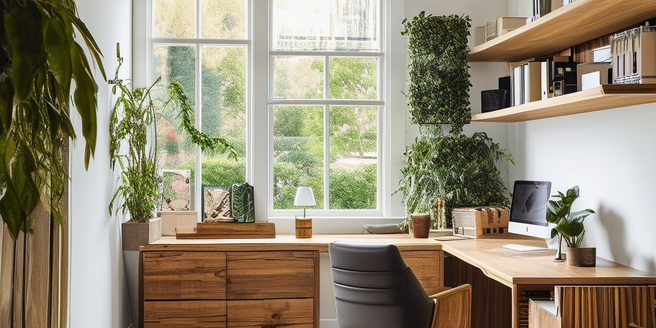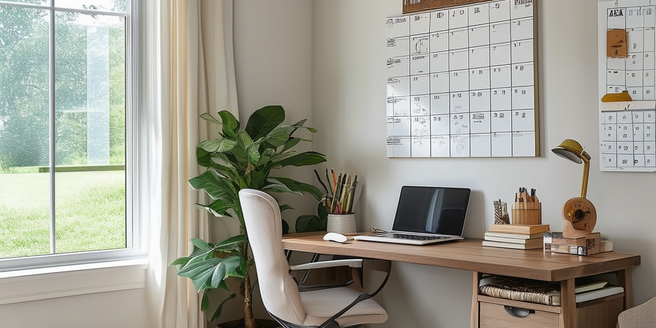
Finding the Right Space for Your Home Office
| Space | Pros | Cons |
| Living Room Corner | Central location, Can monitor kids | Noisy, Limited privacy |
| Bedroom | Private, Quiet | Disrupts relaxation space |
| Basement | Ample space, Quiet | Isolated, Less natural light |
| Attic | Secluded, Spacious | Hot in summer, Stairs issue |
| Garage | Versatile, Spacious | Uninsulated, Potentially cold |
| Dining Room | Close to amenities, Central | Shared space, Noisy |
Choosing Ergonomic Furniture for Comfort and Health
Choosing ergonomic furniture is critical for comfort and health in a home office setup. Comfortable furniture supports good posture and reduces the risk of back and neck pain. An adjustable chair with lumbar support and a desk at the correct height can make a significant difference in comfort and productivity. Look for furniture that is both functional and attractive to suit your home’s decor. Remember to consider the lighting in your home office as it can also impact your comfort level and productivity. Test different chairs and desks to find the best fit for your body and work needs. Ensuring your home office is ergonomically sound can lead to improved focus, efficiency, and overall well-being. Investing in high-quality, ergonomic furniture is ultimately an investment in your health and productivity.
Maximizing Natural Light in Your Home Workspace
Maximizing natural light in your home workspace can enhance your mood and boost productivity. Position your desk near windows to take advantage of daylight. Use sheer curtains to diffuse light, reducing glare on your screen, and consider adding mirrors to reflect light and brighten the room. Try to arrange your office layout to maximize the exposure to natural light throughout the day. If natural light is insufficient, use daylight-spectrum bulbs to mimic the effect. Incorporate light-colored walls and furnishings to create a bright and inviting atmosphere. Plants can also thrive in natural light, adding a touch of nature that can further improve your work environment. With strategic use of natural light, your home office can be both more enjoyable and effective.
Creating a Distraction-Free Environment
Creating a distraction-free environment is key to a productive home office. Start by choosing a quiet location, away from household noise and interruptions. Use noise-canceling headphones or white noise machines to block out sound. Keep your workspace organized and clutter-free to minimize visual distractions. Consider adding some plants to your workspace to improve air quality and create a calming atmosphere. Additionally, ensure that your workspace is well-lit to reduce eye strain and create a more comfortable working environment. Set clear boundaries with family members about work hours and the importance of maintaining focus. Use app blockers and time management tools to avoid digital distractions. By creating a dedicated, distraction-free workspace, you can improve concentration and efficiency, making your work-from-home experience more effective and enjoyable.
Incorporating Family-Friendly Scheduling
Incorporating family-friendly scheduling can help balance work and family life when working from home. Develop a schedule that accommodates both professional responsibilities and family needs. Don’t forget to prioritize self-care as part of your routine. Include breaks to spend time with family, ensuring you stay present and engaged. Communicate your schedule clearly with household members to set expectations and avoid interruptions during critical work periods. Additionally, establish boundaries to maintain a healthy separation between work and family time. Use shared calendars to coordinate activities and commitments. Flexibility is key; be ready to adjust your schedule as necessary. With careful planning and communication, you can create a routine that supports both your work goals and family dynamics.
Using Technology to Enhance Productivity
Using technology to enhance productivity in a home office is crucial for efficiency. Invest in reliable internet service, as a stable connection is the backbone of remote work. Utilize productivity software like project management tools, time tracking apps, and communication platforms to stay organized and connected with colleagues. Regularly updating these tools can prevent potential security risks and ensure optimal performance. Incorporate tools that allow easy sharing and collaboration, such as cloud storage and document editing apps. Ensure your workspace is equipped with necessary peripherals like dual monitors, a quality webcam, and a noise-canceling microphone. By leveraging technology effectively, you can streamline your work processes and maintain high productivity levels from home.
Organizing Your Office for Efficiency
Organizing your office for efficiency is essential for a productive work-from-home experience. Start by decluttering your workspace, keeping only essential items within reach. Use storage solutions like shelves, drawers, and filing cabinets to maintain order. Label folders and create a filing system for easy document retrieval. It may also be helpful to create a daily or weekly cleaning schedule. Arrange your desk setup to minimize distractions and maximize comfort. Consider adding plants or personal touches to create a pleasant environment. Use cable management tools to keep cords tidy. Regularly review and reorganize your workspace to ensure it remains functional and efficient. An organized office can significantly enhance focus, reduce stress, and improve overall work efficiency.
Balancing Work and Family Life
Balancing work and family life while working from home can be challenging but achievable with the right strategies. Establish clear boundaries between work hours and family time by creating a schedule that dedicates specific periods to each. To enhance productivity, consider setting up a dedicated workspace that minimizes distractions. Taking small steps, like organizing your workspace, can make a significant difference. Communicate openly with your employer and family about your availability and commitments. Make use of breaks to connect with your family, ensuring you stay engaged in their lives. Practice self-care by setting aside time for relaxation and activities you enjoy. By balancing work obligations with family responsibilities, you can maintain a harmonious household and a successful professional life.
Designing a Kid-Friendly Home Office
Designing a kid-friendly home office involves creating a space that accommodates both work and family activities. Incorporate a designated area where children can engage in quiet activities like reading or drawing while you work. It’s also helpful to include a calendar or planner to keep track of important dates and tasks. It’s essential to also think about providing adequate lighting to ensure a pleasant and productive atmosphere. Invest in storage solutions for organizing toys and work materials to keep the space tidy. Include comfortable seating for both adults and children to support various needs throughout the day. Utilize child-safe furniture and accessories to ensure a safe environment. By designing a flexible and functional home office, you can successfully balance professional duties with family life.
Maintaining a Professional Appearance on Video Calls
Maintaining a professional appearance on video calls is essential for remote work. Ensure your background is clean and uncluttered, ideally with neutral or professional-looking elements. Dress in appropriate attire as you would in an office setting. Pay attention to lighting, positioning yourself in a well-lit area to avoid shadows. It can also be helpful to test your setup beforehand to identify any potential issues. Use a quality webcam and microphone to enhance audio and visual clarity. Regular practice can turn these habits into a seamless routine. Minimize background noise by working in a quiet space. With these practices, you can present a polished and professional image on video calls, reinforcing your credibility and the importance of your work.

